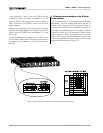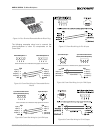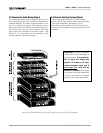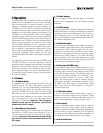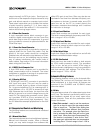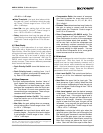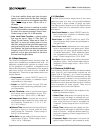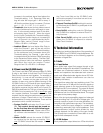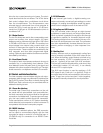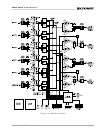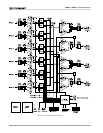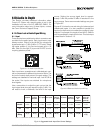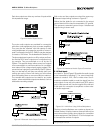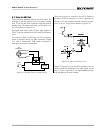
Page 20 IQ–AMB-5 / IQ–SMX-6
Reference Manual
AMB-5 / SMX-6 IQ Mixer/Multiplexer
drive the two current-summing mix buses. The stack
inputs also feed into the mix buses. The VCA's derive
their control voltages from a multiplexer circuit driven
from the microprocessor. The microprocessor uses
onboard
algos
or commands from a host computer to
control the VCAs. Levels can be set in 1/2 dB incre-
ments from 25 dB gain to 100 dB attenuation (which is
considered “off”).
5.1.3 Output Section
The two mix buses are sent to the corresponding main
output and auxiliary bus output stages. All output
stages are active, balanced and can drive 1200 ohms
to +26 dBu or 600 ohms to +20 dBu. The auxiliary bus
output stages have internal relay contact which can
connect or disconnect the signal to the auxiliary bus
output connector. These contacts are controlled by the
host computer and thus allow programmed signal
routing. Optional output isolation transformers can also
be added by the factory.
5.1.4 Level Sense Circuits
The output of each input preamp and each mix amp is
monitored by a corresponding level detector. Each
level detector tracks the peak level of the signal and
releases with a time constant of about 85 ms. The eight
levels are sent to a multiplexer and the A/D converter.
5.2 Control and Interface Section
The host computer communicates with the unit micro-
processor either through an outboard IQ interface (like
the IQ–INT-II) via the Crown Bus, or directly through the
RS232 port. Each unit acts only on commands with an
address matching its own.
5.2.1 Crown Bus Interface
The serial loop (Crown Bus) connections on the unit
are made with an opto-isolated 4-pin removable bar-
rier block connector and a ground stud for the optional
connection of shielded wire. To prevent ground loops,
only the input cable's shield should be connected.
These connections conform to IQ System standards,
which allow the host computer to control numerous IQ
components with the same computer program.
5.2.2 RS232 Interface
Depending on selected options, the DB9 connector
can be used to communicate directly with the host
computer for setup or control of a Crown Bus loop, or
(IQ–SMX-6 only) for connection to an RS232 Crown
Local Net.
5.2.3 D/A Converter
To set channel gain levels, a digital-to-analog con-
verter continuously converts all gain settings to control
voltages. An analog de-multiplexer sends the appro-
priate control voltages to each of the twelve VCAs.
5.2.4 Log Amp and A/D Converter
The A/D converter scans through an eight-channel
multiplexer to read the input and output signal levels.
When a channel is selected, the signal is sent through
a logarithmic amplifier for increased dynamic range.
This analog voltage is then converted to a binary num-
ber that the microprocessor can read. The processor
can then mathematically increase detector time con-
straints, perform averaging or other response func-
tions.
5.3 Auxiliary Port
Auxiliary devices such as supplemental cooling fans
can be remotely controlled via the AUX output on the
unit. When the auxiliary control feature is turned on by
the host computer, 10 VDC is supplied across pin 3
and pin 1 (ground) of the male 3-pin AUX connector.
This port can control solid state relays, and since it has
a current-limit resistor (16 mA max.), it can directly
drive an LED or opto-coupler.
The AUX input function is used by applying a 5-30
VDC signal to pin 2 (with pin 1 as ground). A high or
low signal here will be communicated to the host com-
puter. A logic low can be less than 0 volts (negative);
the signal is internally clamped for circuit protection.



